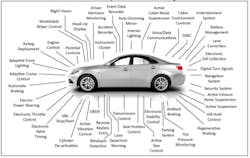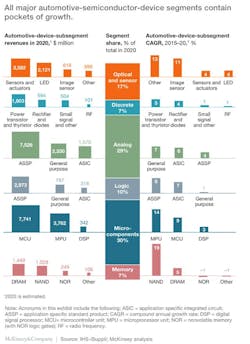By Dan Friedlander
Retired following 44 years in component engineering
Automotive-grade electrical, electronic, and electromechanical (EEE) components are a subsetof the commercial off-the-shelf (COTS) EEE components population. The prime intended applications for the above subset are the automotive ones. Not all the automotive EEE components are COTS. The custom automotive components are not COTS. Only standard automotive-grade components which come from the manufacturer commercial data book are COTS.
With the increasing sophistication of future vehicles, new and more advanced semiconductor technologies will be used and vehicles will become technology centers. The above trend leads to increasing interest of EEE components manufacturers in the business opportunities offered by the fast-growing automotive market.
The space industry, within the use of COTS in space dilemma, is also looking at automotive EEE components. That is OK, pending the subject is fully understood. In other words, it has to be understood what "automotive-grade" really means in terms of quality and reliability. The reference for the discussion is industrial-grade regular, catalog EEE COTS components.
The automotive market
The automotive semiconductor market is not large, compared to the total global market. Nevertheless, it is much larger than the space/military market. The automotive market differs significantly from the space market in that the automotive buyer tends to procure high volumes of a small number of devices, while space buyers tend to procure a low volume of a large number of devices.
When one includes integrated circuits, optoelectronics, sensors, and discrete devices, the automotive electronics market reached around $34 billion U.S. dollars (USD) in 2016, representing less than 10 percent of the total semiconductor market. It is predicted to be one of the fastest growing markets over the next five years.
As per McKinsey&Company data the automotive semiconductors market is growing:
"Between 1995 and 2015, semiconductor sales to automotive OEMs rose from about $7 billion to $30 billion (Exhibit 2). With this increase, automotive semiconductors now represent close to 9 percent of the industry’s total sales. Current projections suggest that sales of automotive semiconductors will continue on their upward trajectory, increasing about 6 percent annually between 2015 and 2020 — higher than the 3 to 4 percent growth predicted for the semiconductor sector as a whole. That would put annual sales for automotive semiconductors in the $39 billion to $42 billion range."
In order not to be misled, it is worth mentioning the estimated automotive semiconductors market per component type.
Acquisitions of automotive electronics specialists by semiconductor giants highlights the semiconductor manufacturers' interest in this particular market. This growing interest may negatively impact the space/military minuscule market.
Automotive EEE component standardization
The Automotive Electronics Council (AEC) is the leading automotive industry entity for automotive EEE Components de facto standardization. The Automotive Electronics Council (AEC) was originally established by Chrysler, Ford, and GM for the purpose of establishing common part-qualification and quality-system standards.
AEC issued AEC - Q100, “Failure Mechanism based Stress Test Qualification for Integrated Circuits,” the leading document for automotive ICs.
Herein the AEC-Q100 is discussed as representing the relevant automotive EEE components methodology. To promote automotive EEE components the above document is cited in different ways, confusing the users not familiar with the content. The relevant used terms are: AEC-Q100 qualified, AEC-Q100 certified, and AEC-Q100 compliant.
The AEC-Q100 explicitly states:
Para. 1.3.1: "Successful completion and documentation of the test results from requirements outlined in this document allows the supplier to claim that the part is ‘AEC-Q100 qualified’."
Para. 1.3.2: "Note that there are no ‘certifications’ for AEC-Q100 qualification and there is no certification board run by AEC to qualify parts."
Para 1.3.2: "Each supplier performs their qualification to AEC standards, considers customer requirements and submits the data to the customer to verify compliance to Q100."
A NOTICE in the document states: "No claims to be in Conformance with this document shall be made unless all requirements stated in the document are met."
We learn that whatever term is used, even the only recognized one (“AEC-Q100 qualified"), all the activities and the final verdict is under the specific automotive EEE Components Manufacturer responsibility. The customer is the only external compliance verifier.
The question is how this works in practice. An automotive user is a high volume, valued customer, that probably has the prerogative to access the manufacturer's qualification data and approve the compliance to AEC-Q100. However, a space small volume user, intending to use an off-the-shelf automotive EEE Component, does not seem to be able to access the data and have any chance to change something.
The applicable car under hood high temperature is up to +150°C. That is outside the industrial operating temperature (up to +85°C). This fact, combined with the issue of high cost military EEE Components, led to establishing the 4 automotive Operating Temperature Grades (ref. AEC-Q100 para. 1.3.4).
Para. 2.1 of AEC-Q100 states: "The objective of this specification is to establish a standard that defines operating temperature grades for integrated circuits based on a minimum set of qualification requirements."
Para. 2.1,1 of AEC-Q100 states: "Qualification and some other aspects of this document are a subset of, and contribute to, the achievement of the goal of Zero Defects. Elements needed to implement a zero defects program can be found in AEC-Q004 Zero Defects Guideline."
"Zero defects" should be referred to as a philosophy, a mentality or a movement. It's not a program, nor does it have distinct steps to follow or rules to abide by.
"The quality manager must be clear, right from the start, that zero defects is not a motivation program. Its purpose is to communicate to all employees the literal meaning of the words 'zero defects' and the thought that everyone should do things right the first time." (Source: Quality Is Free by Philip B. Crosby, McGraw-Hill Books, 1979.
Read more of Dan Friedlander's articles: Click here to visit his page.
Author biography


